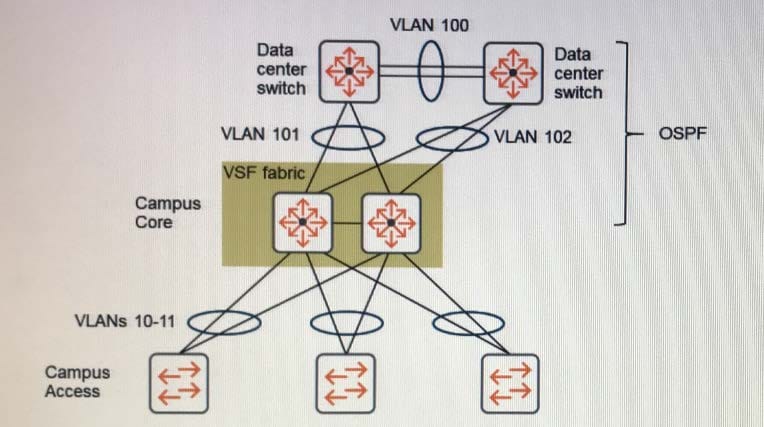HPE6-A47 Online Practice Questions and Answers
An architect needs to plan the bandwidth for two Aruba 7240 Mobility Controllers (MCs) which will connect to the network core. The customer indicates that four 10 GbE links between the network core and the data center will be adequate. The customer expects almost all traffic in the network will be wireless. The customer expects up to 25 Gbps upstream traffic from wireless clients and up to 35 Gbps downstream to wireless clients. The customer requires the MCs to be able to continue to forward traffic if up to one link fails, but lower performance during the failover situation is permissible.
What are the minimal links to meet these requirements?
A. two 10 GbE links on each of the MC
B. two 40 GbE links in each of the MCs
C. three 10 GbE links on each of the MCs
D. four 10 GbE links on each of the MCs.
An architect needs to help a customer design a management and monitoring solution for an Aruba network
in an airport. The solution consists of an Aruba Mobility Master (MM), Aruba 7210 MCs, Aruba AP-335s,
and Aruba 5496R switches.
The architect plans to recommend Aruba AirWare.
The airport has a high-client device turnover and many highly mobile devices. Which changes should the
architect make to the recommended solution based on this characteristic?
A. Recommend additional hardware resources beyond those recommended for the typical tested AirWare platform.
B. Recommend extra AirWare device licenses to support the changing number of client devices.
C. Recommend Aruba Central with a Clarity subscription as a more flexible cloud-based solution.
D. Recommend Aruba Central with guest access licensing to increase guest visibility.
Refer to the exhibit.

The customer requires fast failover if any one link or core device fails.
Which additional technology should the architect plan on the core VSF fabric to meet these criteria?
A. OSPF graceful restart
B. SmartLink
C. BGP
D. VRRP
An architect needs to plan an 802.11ac wireless upgrade for a university building. What is one reason that it is important for the architect to identify auditoriums?
A. Auditoriums typically require a high-density AP design for RF coverage.
B. Users in Auditoriums often have Bluetooth devices, which can be a source of interface in the 5 GHz band.
C. Auditoriums typically require the use of 80 MHz channels to meet bandwidth requirements.
D. Auditoriums often require the use of DFS channels for sufficient 20 MHz channels.
An architect needs to deliver an upgrade to an 802.11ac-based solution for a customer. The customer requires an active site survey for the new deployment.
Which deliverable should the architect provide to the customer?
A. a heat map with proposed AP locations and actual tested coverage
B. a heat map with existing AP locations and actual tested coverage
C. a heat map with sources of RF interface, both 802.11 and non-802.11
D. the heat map with proposed AP locations and predictive coverage
An RF plan specifies wide sector directional antennas.
Refer to the antenna specifications.
H-plane refers to the Azimuth or Horizontal plane and E-plane refers to Elevation or Vertical plane.
Antenna 1: H-plane = 360; E-plane = 120
Antenna 2: H-plane = 360; E-plane = 60
Antenna 3: H-plane = 100; E-plane = 90
Antenna 4: H-plane = 60; E-plane = 60
Which antenna specifications indicate that the antenna is a good choice for the plan?
A. Antenna 1
B. Antenna 2
C. Antenna 3
D. Antenna 4
An Aruba wireless solution for a very high density (VHD) wireless solution consists of a Mobility Master (MM) and two Mobility Controllers (MCs).
What is the best practice design for routing the wireless traffic?
A. The MCs provide the default gateway services for wireless devices and use static routers.
B. The MCs act at Layer2, and the MM acts as the default gateway.
C. The MCs act at Layer2, and core routing switches act as the default gateway.
D. The MCs provide the default gateway services for wireless devices and use OSPF.
A customer needs a wireless solution upgrade. Among the devices that need wireless access are printers. What information about the printers does the architect need to plan the wireless solution? (Select two.)
A. whether the printers are physically locked down
B. the identify of users who need to access printers
C. whether the printers support Power over Ethernet (PoE)
D. whether the printers support 802.1X
E. the 802.11 standards supported by the printer
